TOYOTA YARIS CROSS 2023 Manual PDF
Manufacturer: TOYOTA, Model Year: 2023, Model line: YARIS CROSS, Model: TOYOTA YARIS CROSS 2023Pages: 698, PDF Size: 147.65 MB
Page 71 of 698
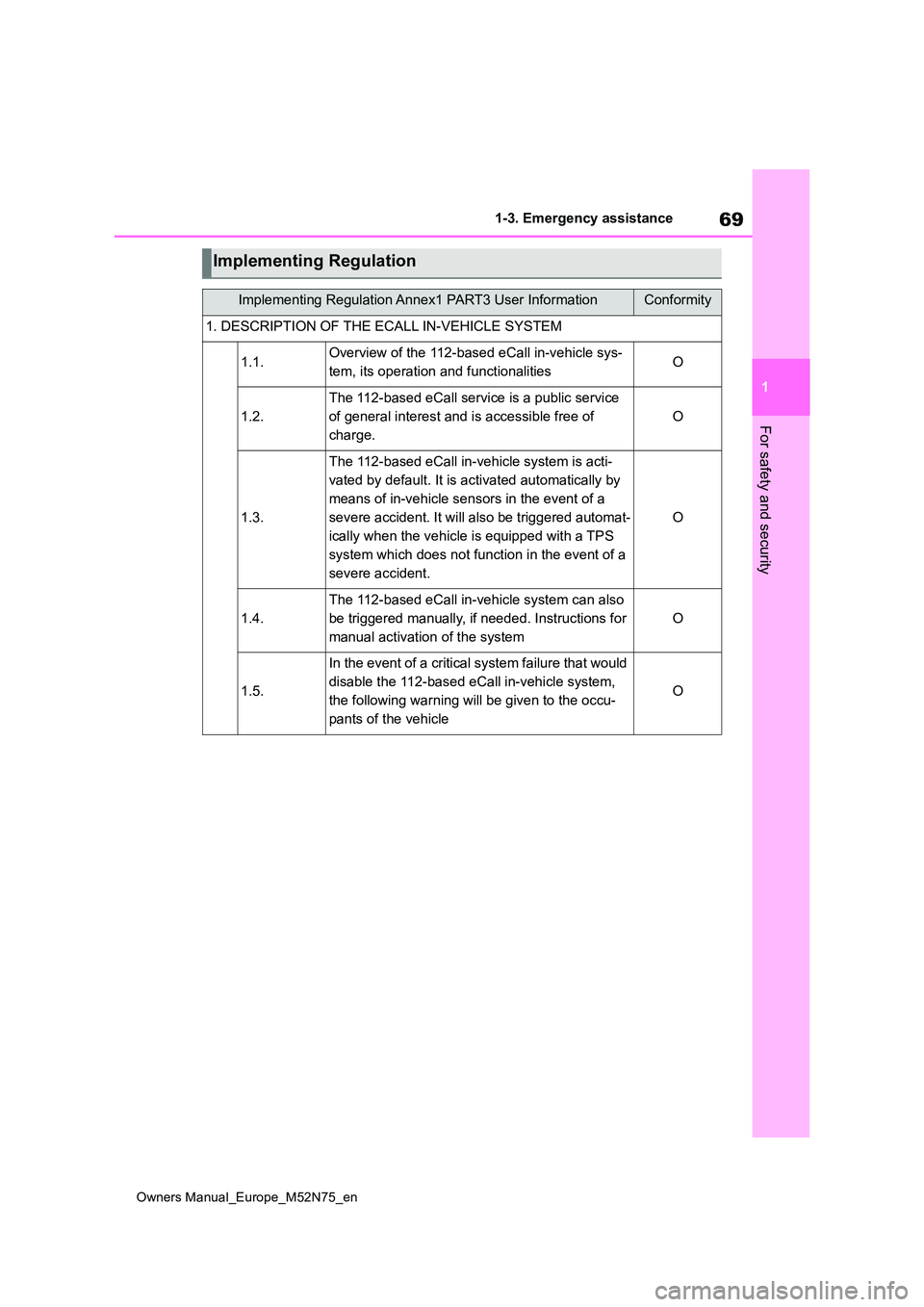
69
1
Owners Manual_Europe_M52N75_en
1-3. Emergency assistance
For safety and security
Implementing Regulation
Implementing Regulation Annex1 PART3 User InformationConformity
1. DESCRIPTION OF THE ECALL IN-VEHICLE SYSTEM
1.1.Overview of the 112-based eCall in-vehicle sys-
tem, its operation and functionalitiesO
1.2.
The 112-based eCall service is a public service
of general interest and is accessible free of
charge.
O
1.3.
The 112-based eCall in-vehicle system is acti-
vated by default. It is activated automatically by
means of in-vehicle sensors in the event of a
severe accident. It will also be triggered automat-
ically when the vehicle is equipped with a TPS
system which does not function in the event of a
severe accident.
O
1.4.
The 112-based eCall in-vehicle system can also
be triggered manually, if needed. Instructions for
manual activation of the system
O
1.5.
In the event of a critical system failure that would
disable the 112-based eCall in-vehicle system,
the following warning will be given to the occu-
pants of the vehicle
O
Page 72 of 698
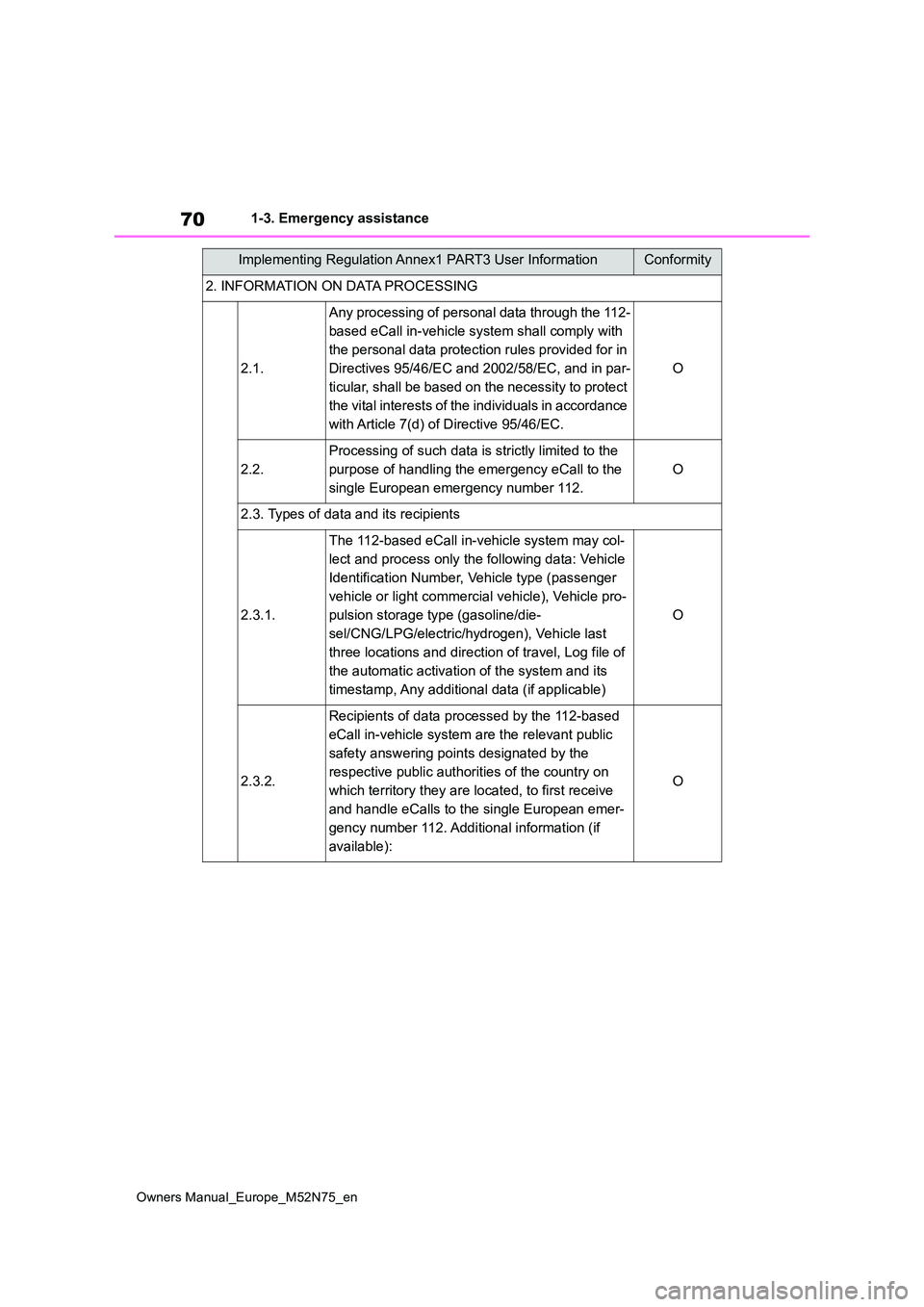
70
Owners Manual_Europe_M52N75_en
1-3. Emergency assistance
2. INFORMATION ON DATA PROCESSING
2.1.
Any processing of personal data through the 112-
based eCall in-vehicle system shall comply with
the personal data protection rules provided for in
Directives 95/46/EC and 2002/58/EC, and in par-
ticular, shall be based on the necessity to protect
the vital interests of the individuals in accordance
with Article 7(d) of Directive 95/46/EC.
O
2.2.
Processing of such data is strictly limited to the
purpose of handling the emergency eCall to the
single European emergency number 112.
O
2.3. Types of data and its recipients
2.3.1.
The 112-based eCall in-vehicle system may col-
lect and process only the following data: Vehicle
Identification Number, Vehicle type (passenger
vehicle or light commercial vehicle), Vehicle pro-
pulsion storage type (gasoline/die-
sel/CNG/LPG/electric/hydrogen), Vehicle last
three locations and direction of travel, Log file of
the automatic activation of the system and its
timestamp, Any additional data (if applicable)
O
2.3.2.
Recipients of data processed by the 112-based
eCall in-vehicle system are the relevant public
safety answering points designated by the
respective public authorities of the country on
which territory they are located, to first receive
and handle eCalls to the single European emer-
gency number 112. Additional information (if
available):
O
Implementing Regulation Annex1 PART3 User InformationConformity
Page 73 of 698
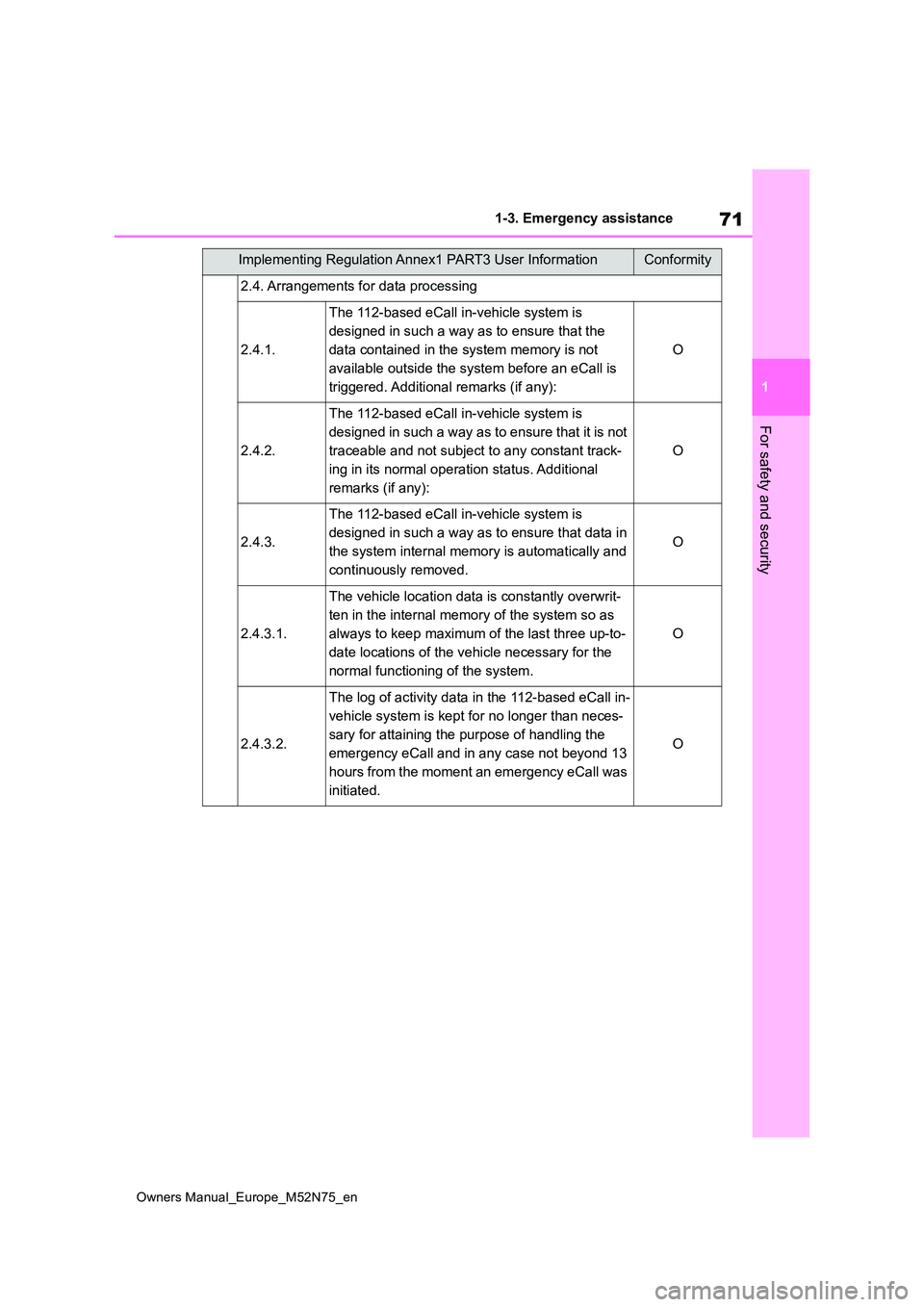
71
1
Owners Manual_Europe_M52N75_en
1-3. Emergency assistance
For safety and security
2.4. Arrangements for data processing
2.4.1.
The 112-based eCall in-vehicle system is
designed in such a way as to ensure that the
data contained in the system memory is not
available outside the system before an eCall is
triggered. Additional remarks (if any):
O
2.4.2.
The 112-based eCall in-vehicle system is
designed in such a way as to ensure that it is not
traceable and not subject to any constant track-
ing in its normal operation status. Additional
remarks (if any):
O
2.4.3.
The 112-based eCall in-vehicle system is
designed in such a way as to ensure that data in
the system internal memory is automatically and
continuously removed.
O
2.4.3.1.
The vehicle location data is constantly overwrit-
ten in the internal memory of the system so as
always to keep maximum of the last three up-to-
date locations of the vehicle necessary for the
normal functioning of the system.
O
2.4.3.2.
The log of activity data in the 112-based eCall in-
vehicle system is kept for no longer than neces-
sary for attaining the purpose of handling the
emergency eCall and in any case not beyond 13
hours from the moment an emergency eCall was
initiated.
O
Implementing Regulation Annex1 PART3 User InformationConformity
Page 74 of 698
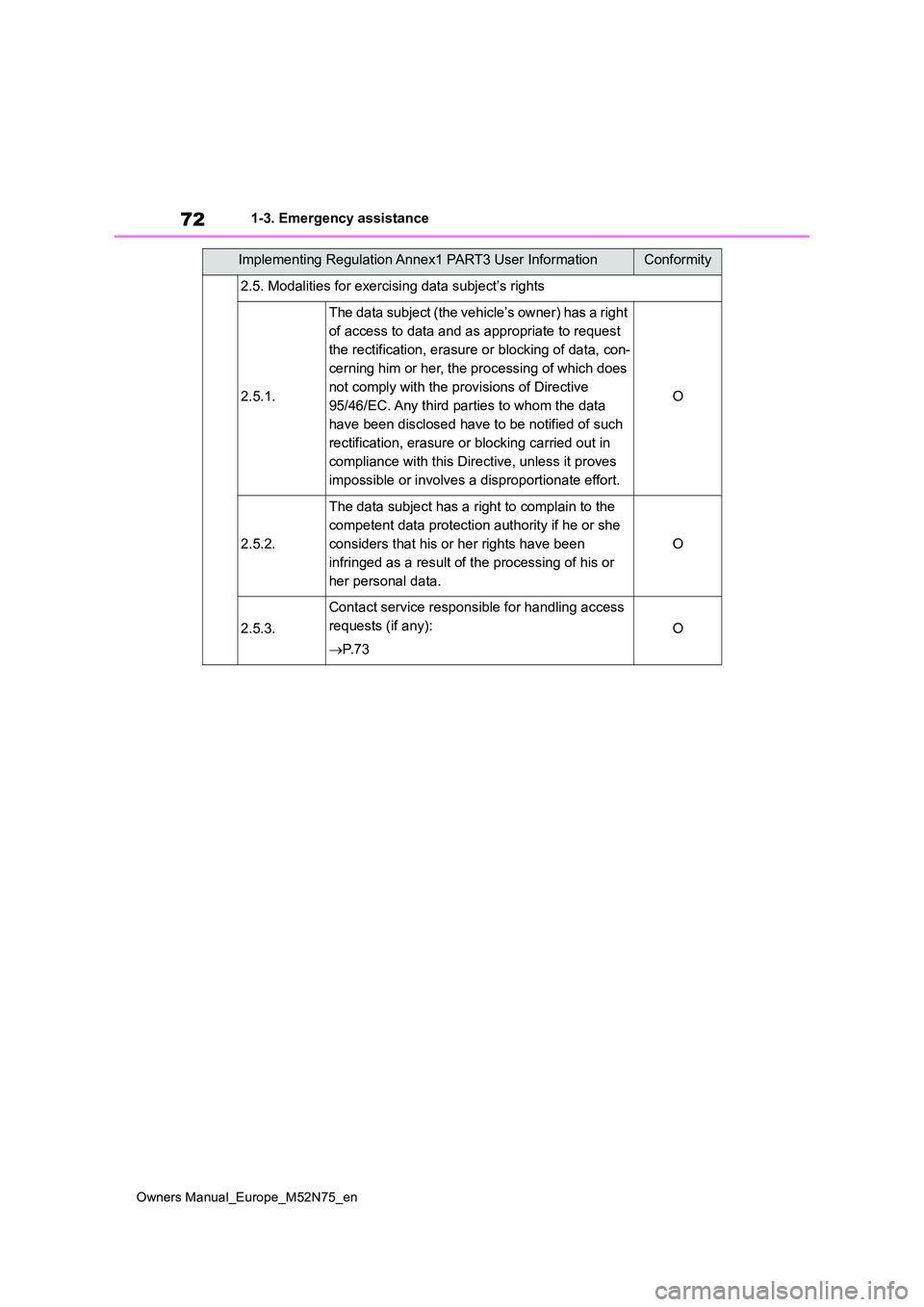
72
Owners Manual_Europe_M52N75_en
1-3. Emergency assistance
2.5. Modalities for exercising data subject’s rights
2.5.1.
The data subject (the vehicle’s owner) has a right
of access to data and as appropriate to request
the rectification, erasure or blocking of data, con-
cerning him or her, the processing of which does
not comply with the provisions of Directive
95/46/EC. Any third parties to whom the data
have been disclosed have to be notified of such
rectification, erasure or blocking carried out in
compliance with this Directive, unless it proves
impossible or involves a disproportionate effort.
O
2.5.2.
The data subject has a right to complain to the
competent data protection authority if he or she
considers that his or her rights have been
infringed as a result of the processing of his or
her personal data.
O
2.5.3.
Contact service responsible for handling access
requests (if any):
P. 7 3
O
Implementing Regulation Annex1 PART3 User InformationConformity
Page 75 of 698
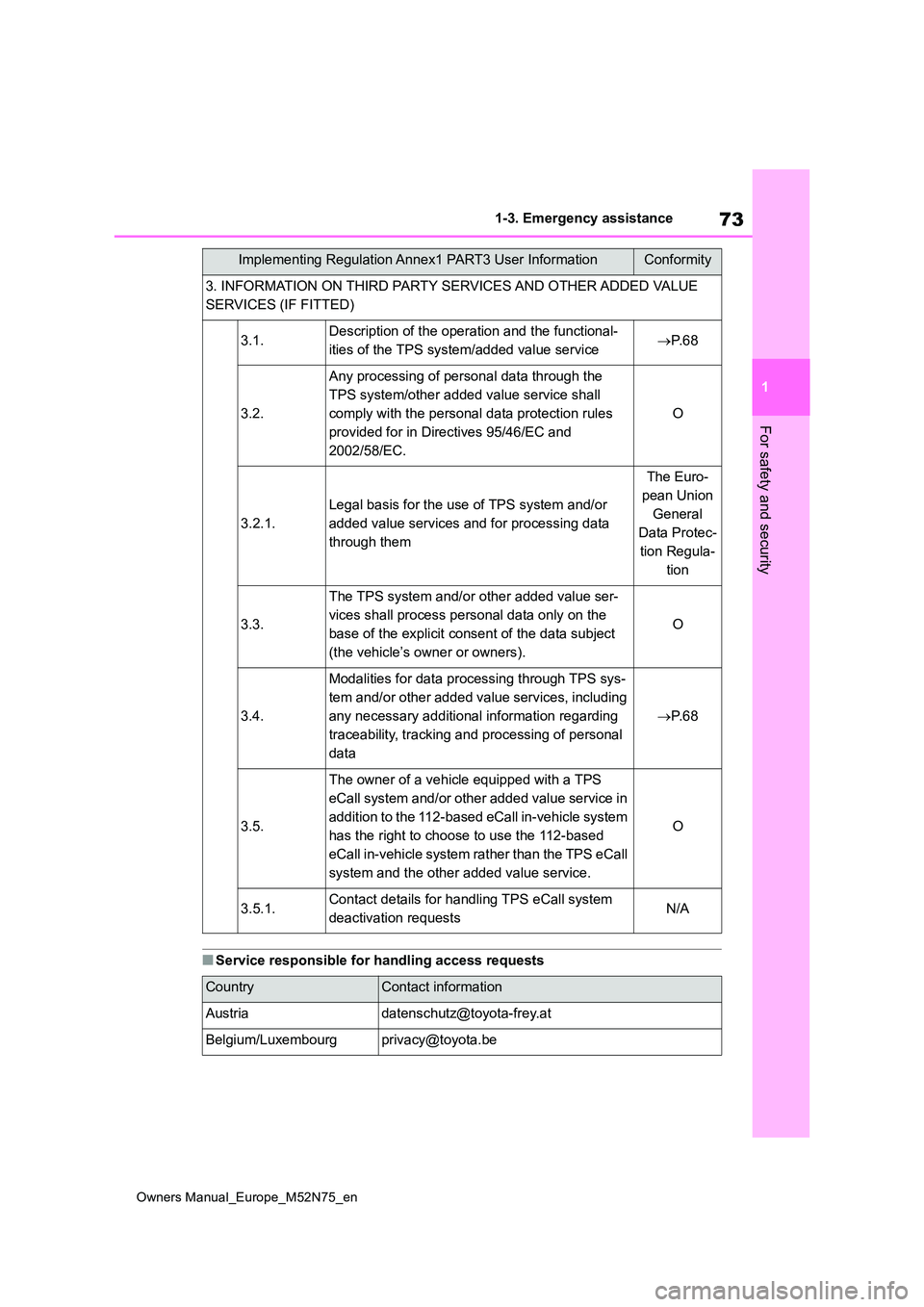
73
1
Owners Manual_Europe_M52N75_en
1-3. Emergency assistance
For safety and security
■Service responsible for handling access requests
3. INFORMATION ON THIRD PARTY SERVICES AND OTHER ADDED VALUE
SERVICES (IF FITTED)
3.1.Description of the operation and the functional-
ities of the TPS system/added value service P. 6 8
3.2.
Any processing of personal data through the
TPS system/other added value service shall
comply with the personal data protection rules
provided for in Directives 95/46/EC and
2002/58/EC.
O
3.2.1.
Legal basis for the use of TPS system and/or
added value services and for processing data
through them
The Euro-
pean Union
General
Data Protec-
tion Regula-
tion
3.3.
The TPS system and/or other added value ser-
vices shall process personal data only on the
base of the explicit consent of the data subject
(the vehicle’s owner or owners).
O
3.4.
Modalities for data processing through TPS sys-
tem and/or other added value services, including
any necessary additional information regarding
traceability, tracking and processing of personal
data
P. 6 8
3.5.
The owner of a vehicle equipped with a TPS
eCall system and/or other added value service in
addition to the 112-based eCall in-vehicle system
has the right to choose to use the 112-based
eCall in-vehicle system rather than the TPS eCall
system and the other added value service.
O
3.5.1.Contact details for handling TPS eCall system
deactivation requestsN/A
CountryContact information
[email protected]
Belgium/[email protected]
Implementing Regulation Annex1 PART3 User InformationConformity
Page 76 of 698
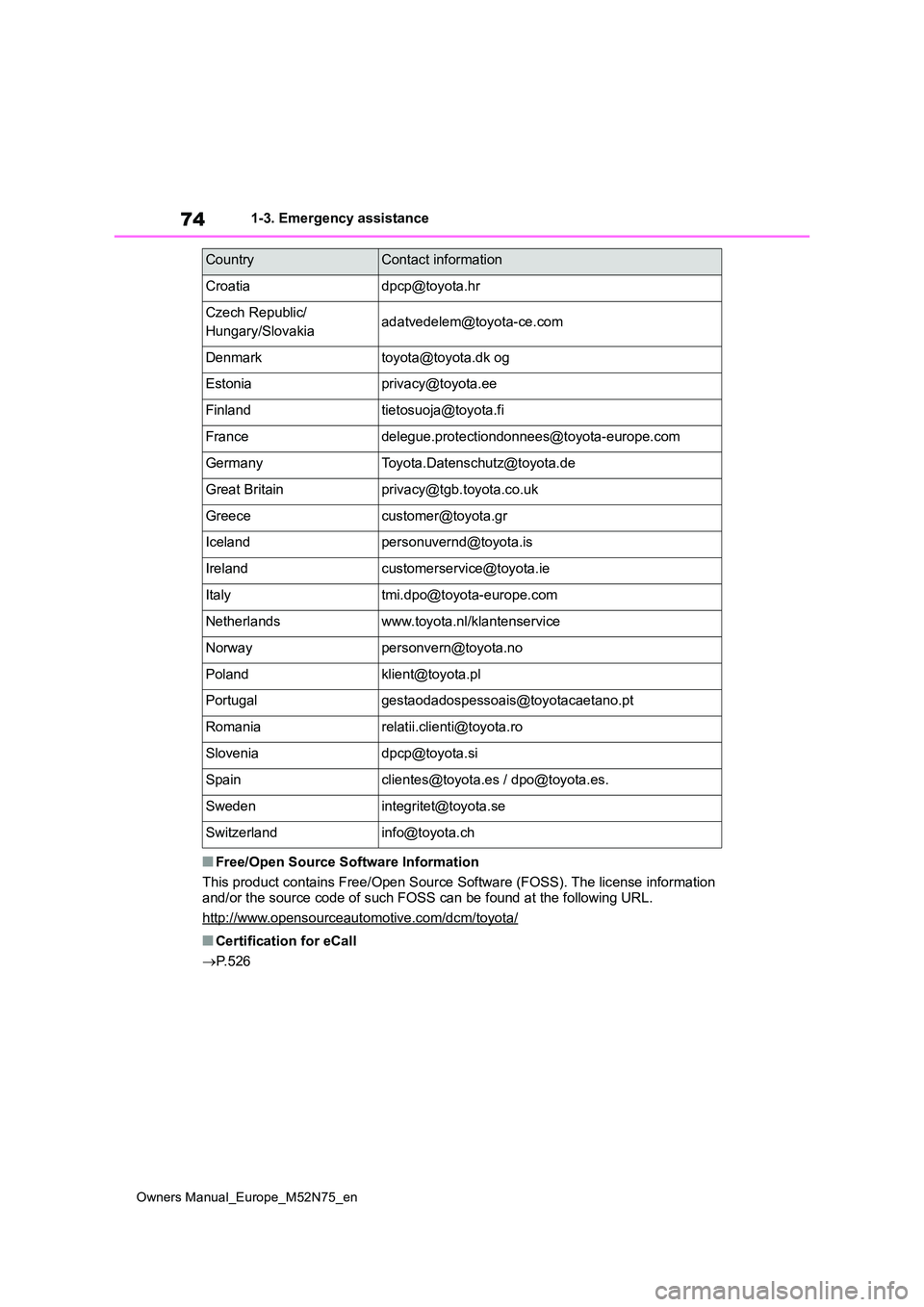
74
Owners Manual_Europe_M52N75_en
1-3. Emergency assistance
■Free/Open Source Software Information
This product contains Free/Open Source Software (FOSS). The lic ense information
and/or the source code of such FOSS can be found at the followi ng URL.
http://www.opensourceautomotive.com/dcm/toyota/
■Certification for eCall
P. 5 2 6
[email protected]
Czech Republic/
Hungary/[email protected]
[email protected] og
[email protected]
[email protected]
[email protected]
[email protected]
Great [email protected]
[email protected]
[email protected]
[email protected]
[email protected]
Netherlandswww.toyota.nl/klantenservice
[email protected]
[email protected]
[email protected]
[email protected]
[email protected]
[email protected] / [email protected].
[email protected]
[email protected]
CountryContact information
Page 77 of 698
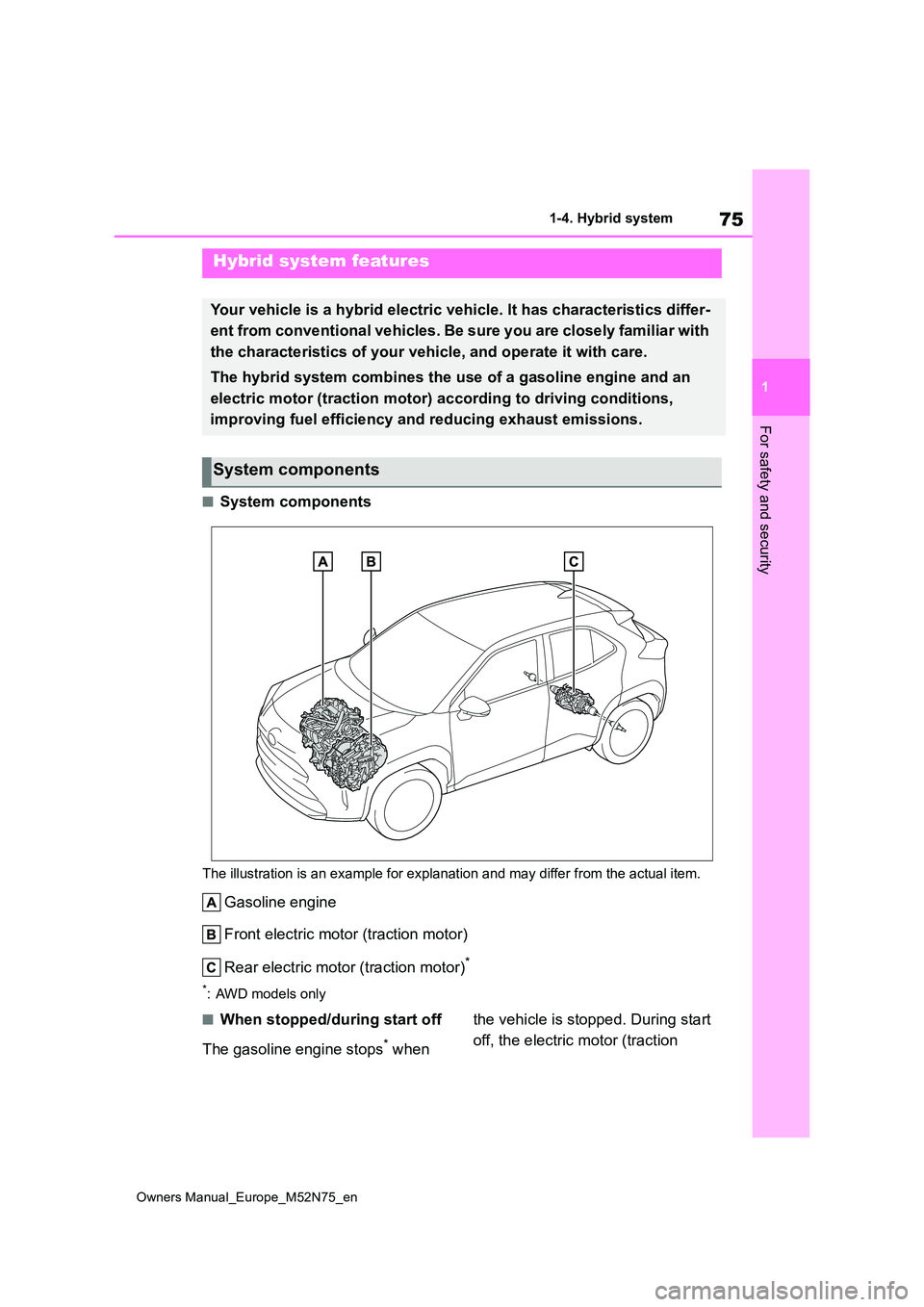
75
1
Owners Manual_Europe_M52N75_en
1-4. Hybrid system
For safety and security
1-4.Hybrid sy stem
■System components
The illustration is an example for explanation and may differ from the actual item.
Gasoline engine
Front electric motor (traction motor)
Rear electric motor (traction motor)*
*: AWD models only
■When stopped/during start off
The gasoline engine stops* when
the vehicle is stopped. During start
off, the electric m otor (traction
Hybrid system features
Your vehicle is a hybrid electric vehicle. It has characteristics differ-
ent from conventional vehicles. Be sure you are closely familia r with
the characteristics of your vehicle, and operate it with care.
The hybrid system combines the use of a gasoline engine and an
electric motor (traction motor) according to driving conditions,
improving fuel efficiency and reducing exhaust emissions.
System components
Page 78 of 698
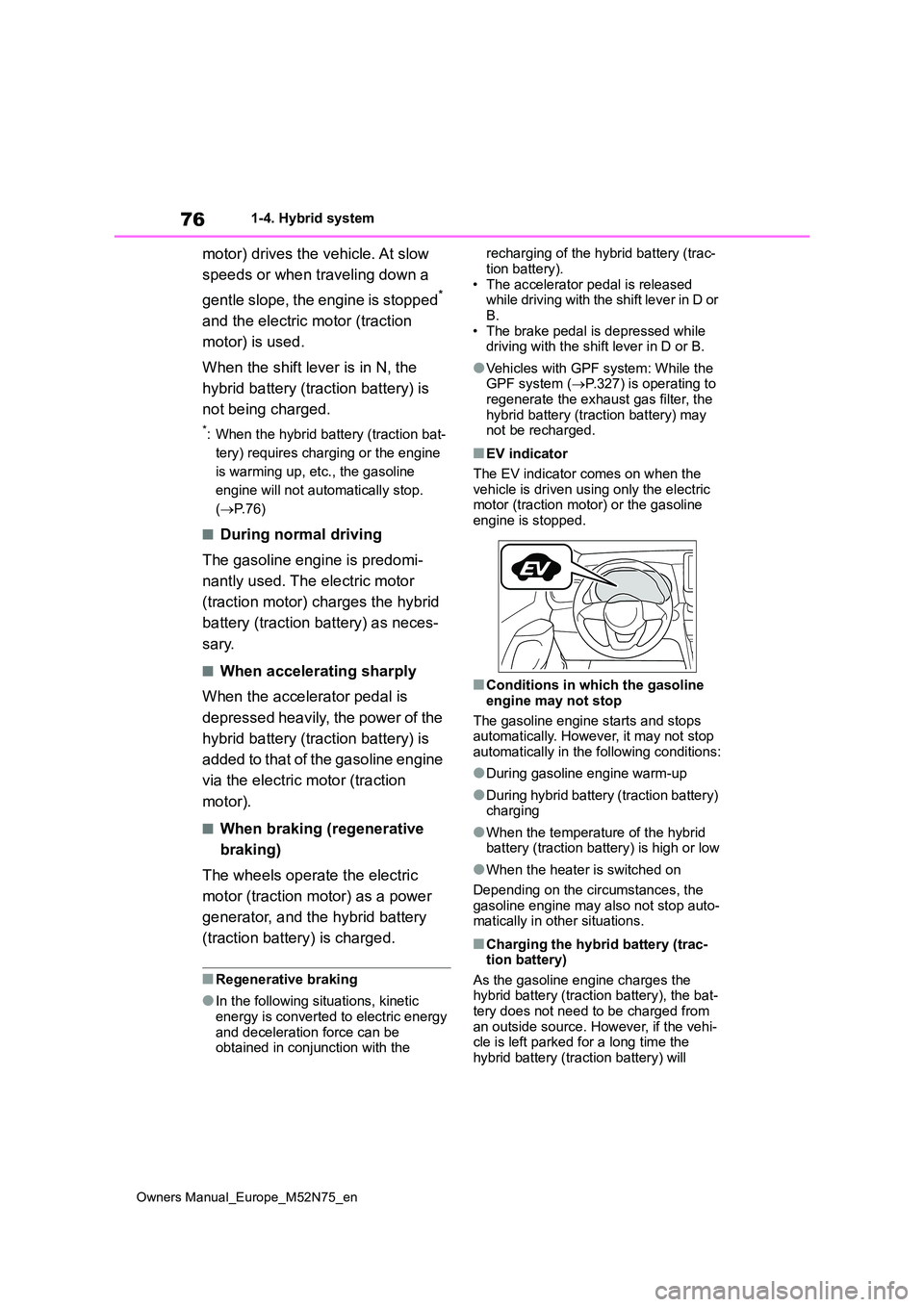
76
Owners Manual_Europe_M52N75_en
1-4. Hybrid system
motor) drives the vehicle. At slow
speeds or when traveling down a
gentle slope, the engine is stopped*
and the electric motor (traction
motor) is used.
When the shift lever is in N, the
hybrid battery (traction battery) is
not being charged.
*: When the hybrid battery (traction bat-
tery) requires charging or the engine
is warming up, etc., the gasoline
engine will not automatically stop.
( P. 7 6 )
■During normal driving
The gasoline engine is predomi-
nantly used. The electric motor
(traction motor) charges the hybrid
battery (traction battery) as neces-
sary.
■When accelerating sharply
When the accelerator pedal is
depressed heavily, the power of the
hybrid battery (traction battery) is
added to that of the gasoline engine
via the electric motor (traction
motor).
■When braking (regenerative
braking)
The wheels operate the electric
motor (traction motor) as a power
generator, and the hybrid battery
(traction battery) is charged.
■Regenerative braking
●In the following situations, kinetic
energy is converted to electric energy and deceleration force can be obtained in conjunction with the
recharging of the hybrid battery (trac-
tion battery). • The accelerator pedal is released while driving with the shift lever in D or
B. • The brake pedal is depressed while driving with the shift lever in D or B.
●Vehicles with GPF system: While the GPF system ( P.327) is operating to
regenerate the exhaust gas filter, the hybrid battery (traction battery) may not be recharged.
■EV indicator
The EV indicator comes on when the vehicle is driven using only the electric motor (traction motor) or the gasoline
engine is stopped.
■Conditions in which the gasoline
engine may not stop
The gasoline engine starts and stops automatically. However, it may not stop
automatically in the following conditions:
●During gasoline engine warm-up
●During hybrid battery (traction battery) charging
●When the temperature of the hybrid battery (traction battery) is high or low
●When the heater is switched on
Depending on the circumstances, the
gasoline engine may also not stop auto- matically in other situations.
■Charging the hybrid battery (trac-tion battery)
As the gasoline engine charges the hybrid battery (traction battery), the bat-tery does not need to be charged from
an outside source. However, if the vehi- cle is left parked for a long time the hybrid battery (traction battery) will
Page 79 of 698
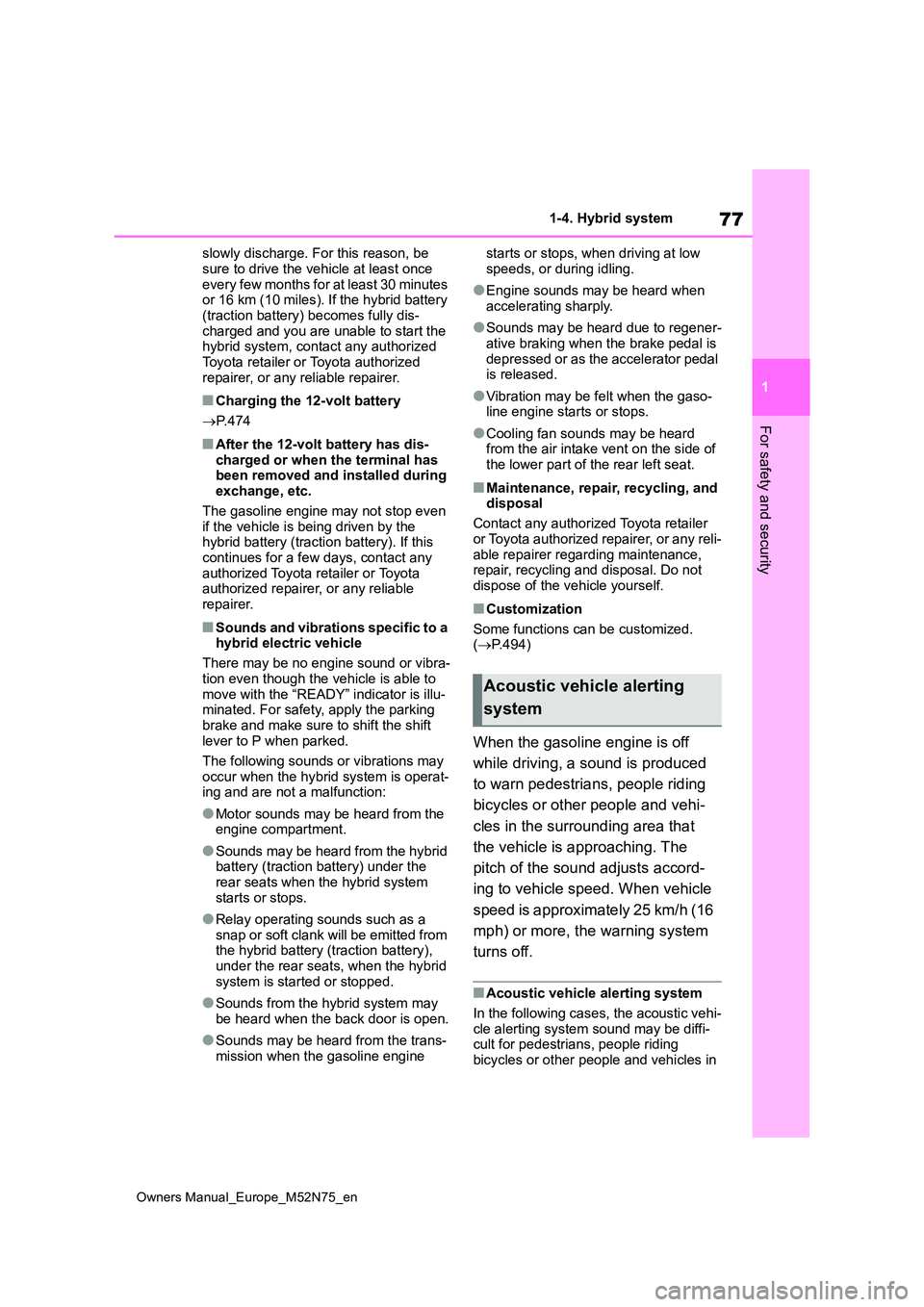
77
1
Owners Manual_Europe_M52N75_en
1-4. Hybrid system
For safety and security
slowly discharge. For this reason, be
sure to drive the vehicle at least once every few months for at least 30 minutes or 16 km (10 miles). If the hybrid battery
(traction battery) becomes fully dis- charged and you are unable to start the hybrid system, contact any authorized
Toyota retailer or Toyota authorized repairer, or any reliable repairer.
■Charging the 12-volt battery
P. 4 7 4
■After the 12-volt battery has dis-
charged or when the terminal has been removed and installed during exchange, etc.
The gasoline engine may not stop even if the vehicle is being driven by the hybrid battery (traction battery). If this
continues for a few days, contact any authorized Toyota retailer or Toyota authorized repairer, or any reliable
repairer.
■Sounds and vibrations specific to a hybrid electric vehicle
There may be no engine sound or vibra-
tion even though the vehicle is able to move with the “READY” indicator is illu-minated. For safety, apply the parking
brake and make sure to shift the shift lever to P when parked.
The following sounds or vibrations may
occur when the hybrid system is operat- ing and are not a malfunction:
●Motor sounds may be heard from the engine compartment.
●Sounds may be heard from the hybrid battery (traction battery) under the rear seats when the hybrid system
starts or stops.
●Relay operating sounds such as a
snap or soft clank will be emitted from the hybrid battery (traction battery), under the rear seats, when the hybrid
system is started or stopped.
●Sounds from the hybrid system may
be heard when the back door is open.
●Sounds may be heard from the trans-
mission when the gasoline engine
starts or stops, when driving at low
speeds, or during idling.
●Engine sounds may be heard when
accelerating sharply.
●Sounds may be heard due to regener-
ative braking when the brake pedal is depressed or as the accelerator pedal is released.
●Vibration may be felt when the gaso-line engine starts or stops.
●Cooling fan sounds may be heard from the air intake vent on the side of
the lower part of the rear left seat.
■Maintenance, repair, recycling, and disposal
Contact any authorized Toyota retailer
or Toyota authorized repairer, or any reli- able repairer regarding maintenance, repair, recycling and disposal. Do not
dispose of the vehicle yourself.
■Customization
Some functions can be customized. ( P.494)
When the gasoline engine is off
while driving, a sound is produced
to warn pedestrians, people riding
bicycles or other people and vehi-
cles in the surrounding area that
the vehicle is approaching. The
pitch of the sound adjusts accord-
ing to vehicle speed. When vehicle
speed is approximately 25 km/h (16
mph) or more, the warning system
turns off.
■Acoustic vehicle alerting system
In the following cases, the acoustic vehi- cle alerting system sound may be diffi-cult for pedestrians, people riding
bicycles or other people and vehicles in
Acoustic vehicle alerting
system
Page 80 of 698
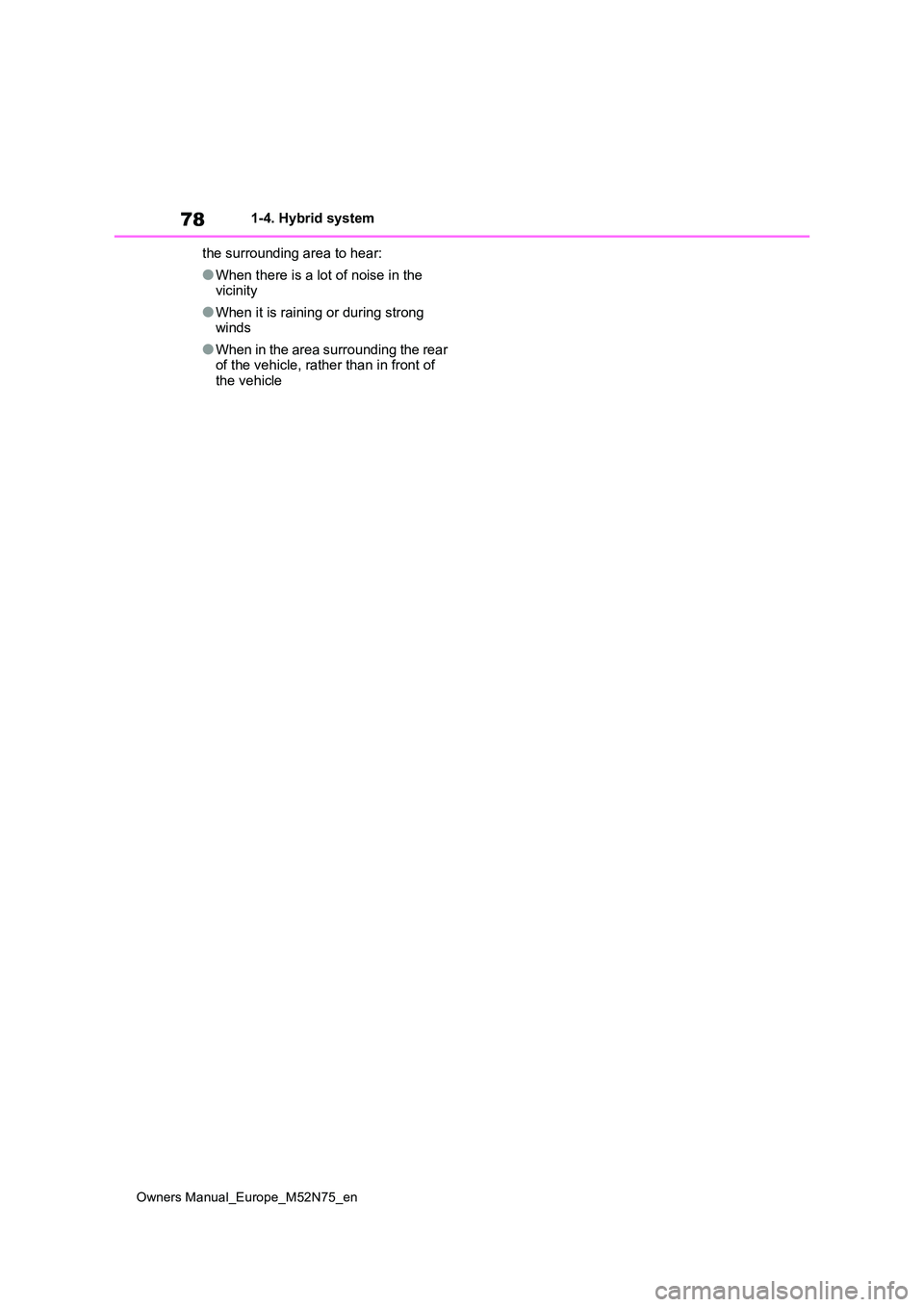
78
Owners Manual_Europe_M52N75_en
1-4. Hybrid system
the surrounding area to hear:
●When there is a lot of noise in the vicinity
●When it is raining or during strong winds
●When in the area surrounding the rear of the vehicle, rather than in front of
the vehicle